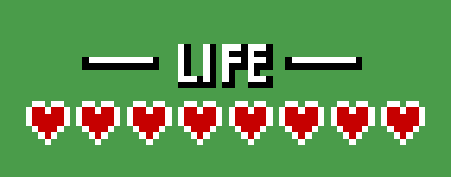By Cathryn Lavrey
Even if you’re not a gamer (which I’m not), you’re probably familiar with the elements of classic videogames, such as the energy/life bar that’s usually on the corner of the screen showing how “alive” you are.
You start off with a full life bar, and then, throughout the game, as you fight battles, your energy bar drops. If you’re lucky, you stumble upon a mushroom or some elixir soup that helps you out. (Okay, maybe I was a LITTLE bit of gamer…)
What if we considered our daily life in the same way?
Every morning we wake up with our energy at its fullest and our willpower at its highest, and we’re ready to take on the day. If this were a videogame, our health bar would be filled up.

Throughout the day, we come up against obstacles. There’s work – personal and otherwise – that depletes our energy to the point where, by the evening (or sooner), we feel like someone literally fried our brain.
When I started into entrepreneurship, I had to start wearing many different hats, some of which did not fit me well. There were tasks and everyday things I had to do that were draining my energy bar to zero quickly and getting in the way of me completing what I considered important tasks.
That was until I came up with a system to leverage my energy better across multiple types of tasks. This system has helped me manage three businesses simultaneously while not feeling burnt out.
Here’s how it works:
Energy Bar Taskmaster
The first part of the formula is understanding how different activities in your day affect your energy. Some activities are energizing, some neutral, and others draining (insert Pac-Man death sound here).
Make a list of the tasks you complete on a regular basis, then categorize them under one of the following:
- Energizing
- Neutral
- Draining
This is a brief overview of how it looks to me:
Energizing activities:
- Designing
- Writing
- Strategizing & Business Development
Neutral activities:
- Creating processes
- Organizing & task assignment
Draining activities:
- Technical stuff, such as dealing with WordPress (which is why I’m thankful to WP Curve and ConvertKit)
- Responding to emails/Customer service
- Managing people
- Anything spreadsheets…
If you’re not sure which task fits into which section, start recording your energy levels throughout the day. Before you begin a task make a note of how you feel, and then make another note after.
In an ideal world, we would all only be working on the energizing activities throughout the day to keep our health bar full. However, this isn’t always possible.
Fortunately, thanks to working with virtual assistants, I can delegate some of the draining work I dislike to do.
Once you know where the types of tasks sit on your personal “energy bar,” you can understand how to leverage yourself, your energy, and your time to be more productive throughout the day without feeling like an empty shell by the end.
2. Sunday Brain Download
You know that feeling when thoughts and lists are flying through your brain faster than you can write them down. Trying to recall these by memory is a drain on your mental energy and should be avoided.
That’s why every Sunday I have a process to download my brain so that I don’t need to try to remember anything.
Here’s how it works:
- Sit down at your computer and write out EVERYTHING you need to get done. Business, personal, and everything in-between.
- Go through this list, and if certain tasks have a specific due date, make a note of that next to the task
- Prioritize each task on a scale of 1 to 3, which mean the following:
- Extremely time sensitive/only you can do it/revenue-generating activity
- Important but not urgent or time-sensitive
- Tasks that need to be done but can be outsourced/done later/not crucial
In the feature download Sunday Process, you’ll see I also have space to calculate the estimated time to complete tasks. I do this so that I can keep on top of how long I think these activities will take versus the actual time they take. Additionally, this way if I can outsource a task, I will know how much time it should take a virtual assistant and how much time I’m saving.
E.N.D. Ranking
Once I have a prioritized list, I go back through the ranking again and put an E, N, or D next to each task (Energizing, Neutral, Draining).
By doing this, I can start to manage my energy better across the projects I need to get accomplished.
Schedule it
Once I have my list prepared I write them into my SELF Journal (however most calendars or planners will work).
My Rules:
- Put all your 1s in first (top priority) with no more than 3 to 5 tasks per day.
- Eat That Frog: Start the day with the hardest (1) tasks first because that’s when your willpower and energy bar are at their fullest.
- Top priority creative work should be done first thing in the morning when the mind is fresh
- Schedule an ‘E’ task after lunch to get me energized
- I only move onto the 2s when my 1 task list for the day is completed.
- The 3s I do whenever I have time/feel like it. If I can outsource these tasks, I will.
Batching
Another great way to keeping your energy bar fuller is by batching similar tasks into one block of time. This way, your brain is not needing to switch between different types of tasks, and you become more efficient.
For example, I batch all of my calls for the week on Tuesdays when possible, mainly because calls interrupt my flow. I’d prefer to get my calls out of the way rather than be interrupted throughout the week. I noticed how much knowing I had a call later in the day would disrupt my productivity, as if my brain was saying, “Don’t get too into a flow yet. You have a call in 3 hours.”
IN 3 HOURS?
That would have been time to get whatever I was doing done, but, for some reason, my brain stopped me getting into a flow knowing a call was coming up. Since batching my calls into one day, I’ve been able to get more done.
Jack Dorsey, co-founder of Twitter and Square explains how he uses this batching in his daily routine to manage his full-time role at both successful companies. For him, each day has a theme, which means he’s working on a particular area of the business for a full day so he can stay focused.
Monday: Management and running the company
Tuesday: Product
Wednesday: Marketing and communications, growth
Thursday: Developers and partnerships
Friday: Company culture and recruiting





